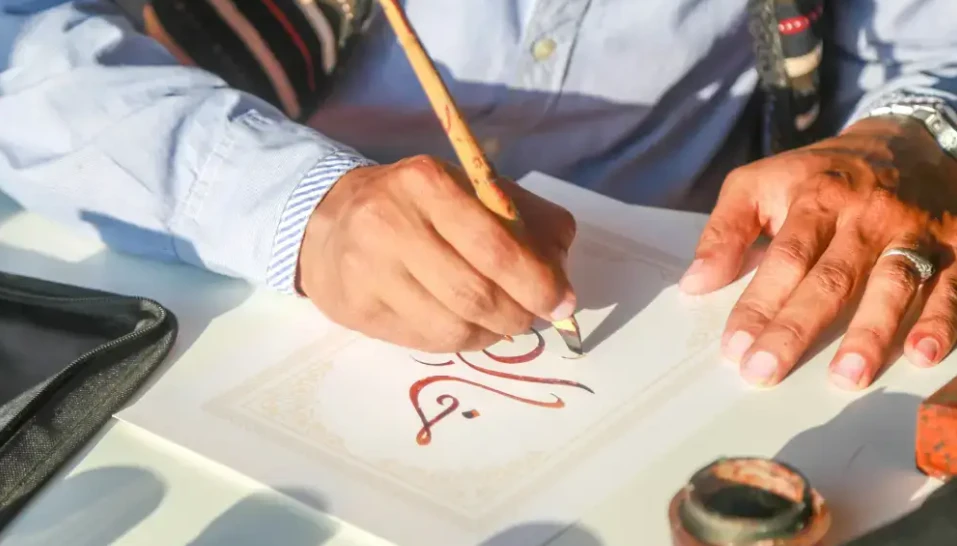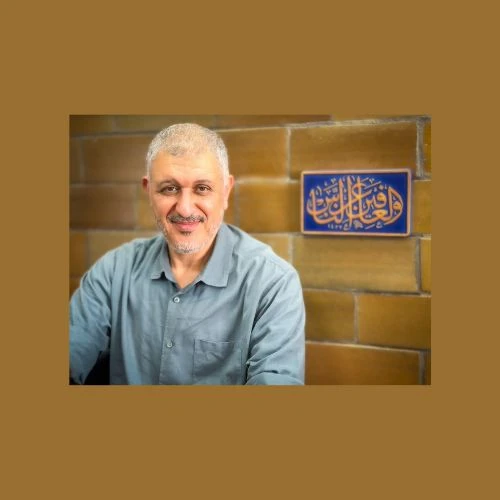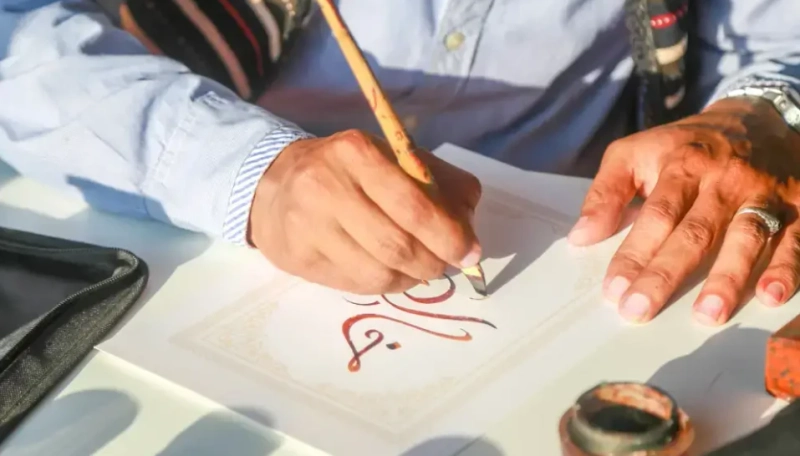Arabic calligraphy is more than beautiful script; it is a language of the soul, a fusion of aesthetic discipline and spiritual devotion.
For centuries, it has been used to decorate mosques and manuscripts and preserve and elevate the Arabic language.
Yet, mastering this delicate art form requires more than talent; it demands years of study, reverence for tradition, and formal recognition from those who have walked the path before. That's what makes the title "certified master of Arabic" so meaningful, and so rare.
Nihad Dukhan, a recognized authority in Arabic and Islamic calligraphy, holds this distinction. His work is not only visually captivating but also historically and culturally grounded.
As a certified master of Arabic calligraphy, Professor Dukhan does more than create art; he educates, preserves, and elevates the craft for future generations.
What It Means to Be a Certified Master of Arabic Calligraphy

The designation "certified master" in Arabic calligraphy isn't honorary; it's earned. The traditional ijaza or ijazat(certification)system is one of the most rigorous mentorship models in the world. It is how calligraphy has been transmitted, master to student, for more than a thousand years.
An ijaza is not just a certificate. It's a formal license to teach and create, issued only after a student has studied intensively under a master, replicating classical scripts with near-perfect accuracy.
The student must demonstrate technical precision, stylistic understanding, and philosophical insight before being granted the right to sign work in a particular style.
Nihad Dukhan received this certification after years of deep study and devotion, making him one of the few in the U.S. to carry such an honor. His ijaza stands as a seal of authenticity, connecting him to a long line of calligraphers who have upheld the discipline and dignity of Arabic script.
A Life Devoted to the Line
Professor Dukhan's journey into calligraphy began not as a hobby, but as a calling. Raised in an Arabic-speaking environment and academically trained in engineering, he combines analytical precision with artistic intuition. This rare duality allows him to approach calligraphy with a deep respect for form and function.
But what sets Dukhan apart isn't just his ability to draw elegant lines; it's the meaning behind them. Each curve, each stroke, results from deliberate choice and cultural knowledge. His pieces embody centuries of Islamic art history, from Thuluth script's strict symmetry to Diwani's flowing grace.
For Dukhan, calligraphy is a conversation between generations. His work honors the masters who came before, even as it invites new audiences into the fold.
From Commission to Canvas: Art with Purpose
As a certified master of Arabic calligraphy, Professor Dukhan offers both original artworks and high-quality reprints. His commissions include personal names, religious verses, poetry, and custom designs. But every project, no matter how large or small, is approached with the same level of craftsmanship.
Unlike digital fonts or automated calligraphy tools, Dukhan's pieces are hand-rendered using traditional tools, reed pens, natural inks, and hand-prepared papers. Each artwork results from intentional design, reflecting the client's vision while maintaining stylistic integrity.
These commissions often serve as meaningful gifts, heirlooms, or centerpieces for homes, mosques, and institutions. They are not just decorative objects but statements of identity and culture.
Educating Through Art
Dukhan's role as a certified master of Arabic isn't limited to the studio. As a professor and lecturer, he is passionate about spreading awareness of Arabic calligraphy's deep cultural and artistic value. He regularly hosts workshops, lectures, and exhibitions nationwide and internationally.
In his lectures, he unpacks the historical evolution of Arabic calligraphy, its connection to Islamic civilization, and its modern-day relevance. In hands-on workshops, he teaches students how to hold the pen, prepare the ink, and execute basic strokes, often unlocking a creative spark they didn't know they had.
Through these efforts, Dukhan isn't just teaching technique; he's building bridges. For many, his workshops are their first introduction to Arabic script as a form of art, rather than a symbol of foreignness. This makes his role especially important in diverse communities where cultural literacy is vital.
Exhibitions That Speak Volumes
Dukhan's calligraphy has been featured in numerous solo and group exhibitions. These events allow the public to engage directly with Arabic calligraphy, not as exotic or remote, but as a living, breathing art form.
The emotional impact of seeing large-scale calligraphy in person cannot be overstated. In a digital world, the handcrafted nature of Arabic calligraphy brings people back to the tactile, the human. The shapes are precise, but the impact is emotional. Each letter becomes a work of art. Each word carries both aesthetic and spiritual weight.
Dukhan's exhibitions aren't passive; they're educational. He often pairs artwork with descriptions that explain not only the meaning of the text but the calligraphic style used and its historical context. Visitors leave not only moved by the beauty but also enriched by the knowledge.
Why Certification Matters in Arabic Calligraphy
Certification matters more than ever in an era when anyone can download a font and replicate the look of Arabic script. It signals not just skill, but legitimacy. When someone is a certified master of Arabic calligraphy, they are recognized by their peers as someone who upholds tradition, teaches with integrity, and works within an unbroken historical lineage.
This certification acts as a safeguard against misrepresentation. Calligraphy is sacred in Islamic culture; it shows how the Quran was preserved and how generations have expressed spiritual devotion. To treat it merely as decoration is to miss its depth. That's why it's critical to support artists like Dukhan who carry the art with reverence and knowledge.
Preserving a Cultural Legacy
In many ways, Professor Dukhan's work is about preservation. In a time when traditional arts are being eclipsed by fast-paced digital design, his calligraphy stands as a powerful counterpoint. It says: slow down, look closer, listen to the line.
But he's also moving the tradition forward. Using color, form, and contemporary layouts, he keeps Arabic calligraphy relevant to modern audiences without compromising its integrity. This balance, between old and new, discipline and creativity, defines a true master.
Supporting the Art
Owning a piece of Arabic calligraphy from a certified master like Nihad Dukhan isn't just an aesthetic choice; it's a cultural investment. Whether you're purchasing an original, commissioning a custom design, or attending a workshop, you're continuing a rich artistic tradition.
His reprints offer an affordable entry point into the world of authentic calligraphy. At the same time, his originals allow collectors and institutions to own one-of-a-kind expressions of an ancient art.
Final Thoughts
Arabic calligraphy is more than a visual experience; it's a spiritual and cultural journey. And at the heart of that journey is the certified master of Arabic: the person who has dedicated their life to the discipline and carries the torch of tradition with skill and humility.
Nihad Dukhan is one such master. Through his work, he invites us all to slow down, look deeper, and discover the meaning within the line.
Explore More or Commission Your Work
To learn more about Professor Nihad Dukhan, view his gallery, or commission a personalized piece of Arabic calligraphy, visit website.
Whether you're an art student, a collector, or simply someone who appreciates beauty with meaning, this is your chance to connect with one of the few true certified masters of Arabic calligraphy working today.



